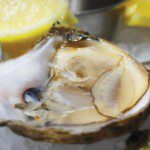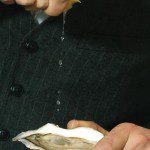All About Oysters
By • November 3, 2011 0 1360
Seafood lovers know the Washington area for its great crabs. The Maryland Blue Crab, a summertime luxury, keeps the Delmarva area swirling in culinary excitement every season, and signs for All-You-Can-Eat Snow Crab legs clutter the streets of beachside towns up and down the Chesapeake. But one hundred years ago, D.C. was known for its oysters, and over the last 10 years these coin-sized delicacies have been making a thundering resurgence.
“If you go back to circa 1890, 1900,” says David Moran, the managing director of Clyde’s of Gallery Place and Old Ebbitt Grill, “Washington, D.C. had over 150 oyster bars in the city.” Discussing oysters and wine with Moran at one of his bars in Clyde’s, acute rays of dusk flooding in streams of gold leaf through the windows, the afternoon seems more like a scene from a James Stewart flick than a scheduled interview. Moran’s restaurant effortlessly maintains a certain timeless American appeal — lacquered rosewood runs the length of the bar tops, and the buzz of customers seem to be as much a part of the design plan as the atrium-like conservatory room.
Moran’s enthusiasm for oysters is contagious, and he is proud of this area’s longstanding history surrounding bivalve food culture. “This was one of the hotbeds in the country,” he exclaims. “All they served were oysters and beer.”
Loved by the royal and working class alike, oysters occupy a unique intersection on the culinary map. An average Joe may not regard foie gras or salmon roe with particular enthusiasm. Likewise, try feeding livermush and coleslaw to a Washingtonian, and one will understand the very nature of dark comedy. Oysters, on the other hand, are universally understood and appreciated.
In ancient Rome, an oyster would fetch its weight in gold. Emperors, so enamored with these briny delicacies, would send droves of slaves into the English Channel to gather them. Contrarily, modest fishermen from Europe to Japan have lunched on mollusks for a millennium, and barely a century ago in this very city, oysters were the preferred bar fare of off-duty day laborers and wharf grunts. Today, oysters can fetch upwards of $3 a bite at fine dining restaurants, or one can knock back oyster shooters for a buck-fifty at O’Brien’s in Annapolis.
Unfortunately, the Chesapeake oyster population had dwindled to about 1 percent of its population from the late 19th century, due to overfishing, pollution and disease, and the Washington area oyster culture was nearly lost. Thankfully, due to population restoration efforts, sanctuary reefs have been set up to redeem the species, and more efforts are in the works. The reefs, set up five years ago, are now home to around 180 million native oysters.
Most oysters that find their way to the raw bar these days are harvested in oyster farms. Not only has this unique method of farming been pivotal in maintaining oyster populations for restaurateurs and consumers, they have in fact created entirely new varieties of oysters.
Though oysters can be broken down from three broad regional varieties — Eastern oysters, also known as Gulf or Atlantic oysters, European flat oysters, or Belons, and Pacific oysters — oyster farmers today can effectively treat their product as winemakers treat grapes. “If you take a chardonnay grape and grew it in southern Napa versus northern Napa, you’d get different flavor profiles,” explains David Varley, executive director of Bourbon Steak in Georgetown. “Same thing works with oysters. If you take an oyster and put it in a certain bay of water, it filters that water and picks up that area’s unique flavor profiles.”
Sharp and engaging, Varley has an encyclopedic knowledge of all things shellfish.
The way he can rattle off the names of oyster farms, harvesting techniques, and flavor characteristics, vaguely recalls a rambling Bob Dylan.
Having invited me to an oyster tutorial, Varley and I stand behind the bar by the serving counter of his kitchen. Before us sits a tray of softly crushed ice filled with nothing but a lemon wedge wrapped in cheesecloth and an inconceivably small bottle of Tabasco. In a similar platter sits a dozen oysters, not yet shucked. It is difficult to focus on anything when you know you are about to be eating fresh oysters, like the last few minutes of work on a Friday afternoon, but Varley manages to keep me engaged.
“There are couple different methods for growing oysters,” he tells me. “Hanging baskets is pretty much the dominant one on the east coast.” Oysters are hung at different ocean depths in baskets, suspended off the ocean’s floor by strings floated by buoys. “So you go pull a line up, crack open your box of oysters, power wash them, get rid of any starfish.” With the mention of starfish, my clear amusement is promptly shamed by the grave severity of Varley’s eyes.
“Starfish are the enemy of oyster farmers,” he says, daring me to find this funny. “They’ll just latch on to the oyster and pry them open. And they travel in packs like herds across the sea floor. It’s pretty nuts.”
I make a note to myself not to ever joke about starfish with an oyster farmer.
There are a slew of benefits to harvesting oysters over plucking them wild from the ocean floor. There is the peace of mind in knowing they are clean of unwanted pathogens, having been maintained by marine agricultural professionals. Fecal coliform is not a particularly pleasant bacteria to host.
But there are also indulgent advantages. Wild oysters, for one, do not naturally grow as deep in their shell as customers are accustomed to seeing. The deep-cupped shell, which retains the oyster’s delicate liquor, is a harvested characteristic. “Wild oysters,” says Varley, “like the shells at the beach, are flat and have that oblong shape. Oystermen chip the flat side of the shell, and the oyster will compensate by growing deeper.”
The ‘R’ Myth
Talk of harvesting and sanitation begets a single inquiry that seems custom tailored to chafe the nerves of any chef or restaurateur in the oyster business. The ‘R’ myth has been swirling about mollusks almost as long as the ocean currents themselves. Rumor has it that one should only eat oysters in the months which names contain the letter R. The remaining months—the consecutive summer months—are said to be an unsafe time to consume oysters.
“It really had a lot to do with a lack of refrigeration back in the day,” Moran explains. “You wanted to eat oysters in the cold months, so you knew they were unspoiled. So you’d eat them in November, December … only the months that have the letter R in them. And in the summer months you’d lay off them.”
Luckily for us “shellfishionados,” this myth has been thoroughly debunked. With the modernization of the industry, proper cooling and transportation allow restaurants to get safe oysters any time of year. In the summer months, business begins going further north into Canadian waters and British Columbia, where the water remains icy cold and the oysters grow at greater depths.
“I think my oysters often fly better than I do,” jokes Moran. “You pick them up in an inlet, they’re flown first class, and they’re on the plate at the Old Ebbitt the next day.”
Supplies are not as bountiful in the summer months, as any oysterman will admit, and there is less variety from which to choose. But safety and quality is no longer anything of concern.
The good news is that with every ebb, there comes a flow. There is a best time of year to eat oysters. Right now. “The oysters are eating a lot, right now” Varley says, “preparing themselves for the summer, for the spawn. So in the later months of winter they’re going to be the plumpest, definitely at their crispest, their peak of flavor in the winter months.”
Shucks
The crux of any oyster program is in the creatures being opened only after the customer orders them. “You can tell if they weren’t shucked to order,” says a visibly distressed Moran, the idea alone enough to distract him momentarily. In prior decades it was common for oysters on a menu to be pre-shucked and refrigerated on a sheet pan. This irritates Moran. “They’d have dried out from being shucked hours ago… They’re living organisms until you pop that shell,” he says. “You can taste the freshness.”
Speaking later with Varley, it becomes evident that abusing an oyster is a universal transgression of seafood specialists. “Nothing is worse than anticipating a great oyster, and getting a plate of shells, or having them chopped up into a million little pieces,” says Varley with a veteran air of frustration. With this he takes his oyster knife, a cross between a dinky ice pick and a butter knife (or as he puts it, a prison shank), and rolls a small green towel half way to the center.
“There are two methods of shucking oysters,” he says, picking up a shimmering, marbled beauty that he has been teasing for a while. “One is popping them at the hinge, and the other is stabbing them through the top shell and then slitting the connector muscle.”
He places the oyster with its hinge on the rolled half of the towel, cup side down, and folds the other half of the towel over the top of the shell. His right hand holds the oyster firmly in place beneath the towel. He explains that he prefers to shuck through the hinge because the knife can get a better foothold. He sticks the blade into the seam and the top shell begins to move. After twisting the knife once or twice, he drives it just enough to penetrate the top and bottom shells completely. There is an audible pop. “That’s the back hinge breaking,” he says with a roguish smile.
He wipes the residual dirt from the knife and moves it carefully into the opening at the hinge along the inside ceiling of the shell. “You want to separate the meat from the top. Ever so gently slice through the top adductor muscle.” Voila. The top shell comes off without protest. A picture perfect oyster.
It doesn’t take long for him to sever the muscle underneath the skirt on the other side and free up the glistening little booger. Now we are ready to eat.
Chew vs. Gulp
Among oyster connoisseurs, it is commonly agreed upon that one should not embellish the oyster with superfluous toppings. A squeeze of lemon perhaps, but tartar sauce, mignonette sauce and horseradish merely diminish the experience of this briny treasure, with its subtle variations of refreshing sweetness, salty, crisp flavors, and feathery soft meat. However, there appears to be a raging debate of a different order: shalt thou chew or shalt thou gulp thy holy sacrament?
“I chew ‘em,” says Varley with nonchalance. “I’m not trying to hide from them.” Well, it’s his kitchen. Let’s do it his way. Biting down on the morsel, I find it so light that my teeth hardly notice its presence. An initial briny minerality from the liquor gives way to sweet, clean tasting meat. There is a distinct and pleasant beachiness that floods my senses like a familiar scent, reminding me of naps in the sand of Hilton Head Island and boat rides down the Chesapeake. I realize that I have never tasted anything this fresh. Score one for Team Chew’Em.
“Gulp,” says Moran without a moment’s hesitation. “Just squeeze some lemon, pick up the shell and pour them right in your mouth.” There are oysters in front of us, and he graciously demonstrates. I join him. The man makes a persuasive argument. It was a Raspberry Point oyster, with a taste like cucumbers and melons. There is a particular satisfaction in slurping down the entire beast, like jumping off the high dive and feeling the thrill of weightless liberation. A cool sweetness lingers seductively down my throat.
“If they’re done right, it’s perfect right there. I am a gulper of wine and oysters,” laughs Moran. My standing on the matter of Gulp VS Chew is split, and I can see that will not be the one to resolve this timeless debate. Can’t we just do them both?
Drink Pairings
I have a beer in front of me. I chase down my oyster, and the bite from the lager refreshes my palette and readies my tongue for another oyster — a beautiful sensation. The art of pairing drinks with oysters is a specialty hobby, and some take it rather seriously. Moran, for instance, holds an annual oyster and wine pairing competition throughout the month of October. Last year, he sampled around 350 wines with oysters over the course of a few weeks. Not a bad job, he admits with a laugh.
As a definitive rule, red wines do not pair well with oysters. “It’s just the texture and structure of them,” says Moran. Cabernets and merlots overpower the oysters’ delicate flavors. “They’re very tannic. It dries your mouth and you can’t taste the oysters.”
The types of wine to drink with oysters are crisp dry white wines, refreshing palette cleansers. “You’re looking for a wine that will prepare your mouth for your next oyster,” offers Moran.
Specifically, Moran has learned, New Zealand sauvignon blancs have been the regularly prevailing champions of Moran’s annual competition. He explains, “Two years ago, out of the 340 we had entered, our entire top 10 — and we do this competition blind, we don’t look at a label until this competition is over — all 10 winners were New Zealand sauvignon blancs.”
These New Zealand wines have a powerful fruit explosion up front. If sipped independently, these wines are often too much of a fruit bomb. For oysters, however, it has a wonderful balance of acidity, which cuts one’s palette, leaving taste buds refreshed and tingling. “It’s almost like it prepares your mouth for the next oyster,” says Moran. “When you take the wine with the saltiness and brininess of the oyster, it’s a perfect combination.”
Whatever the pairing, a great oysters is a welcomed luxury. In the prime of the season, with Island Creek oysters coming fresh from Ducksbury Bay and the local catch from Rappahannock Oyster Company rolling into markets and restaurants daily, Washington’s oyster culture is alive and well.
- Garrett Faulkner
- Garrett Faulkner




